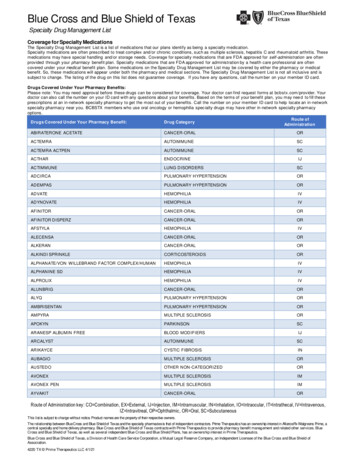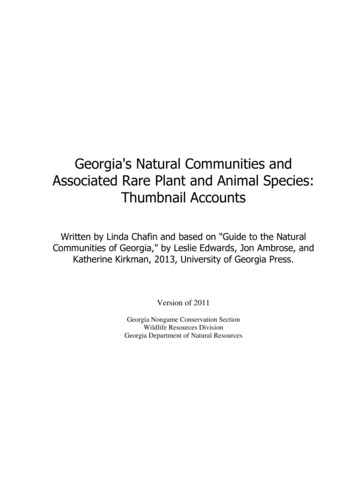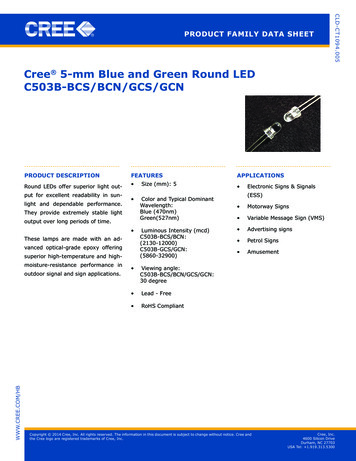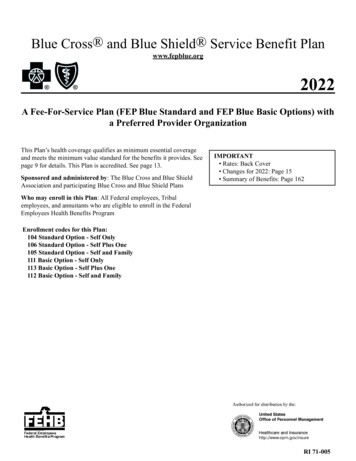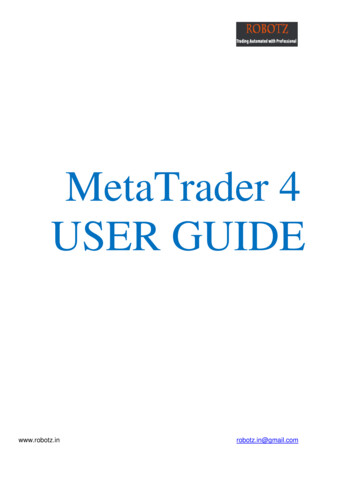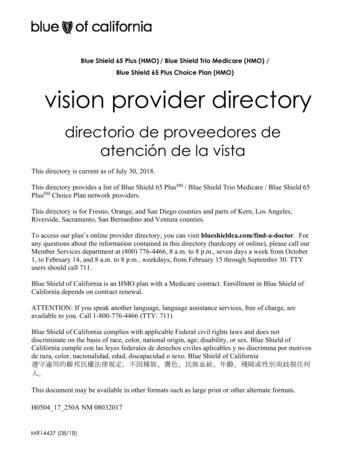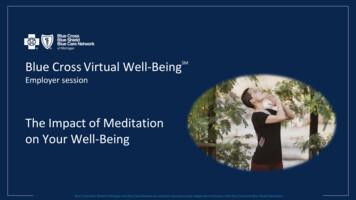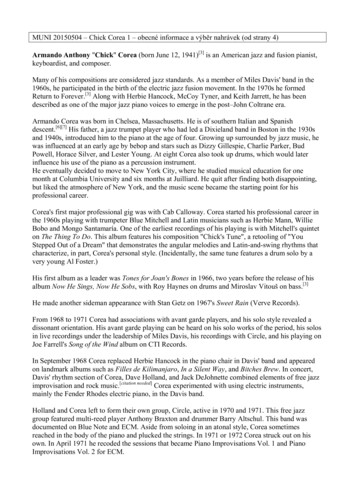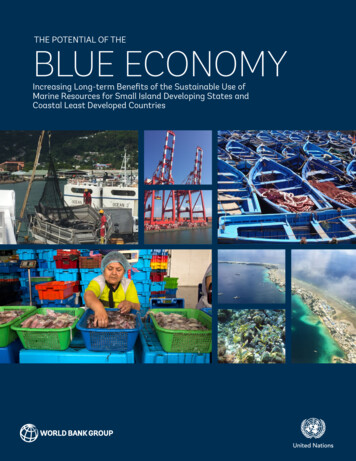
Transcription
THE POTENTIAL OF THEBLUE ECONOMYIncreasing Long-term Benefits of the Sustainable Use ofMarine Resources for Small Island Developing States andCoastal Least Developed Countries
THE POTENTIAL OF THEBLUE ECONOMYIncreasing Long-term Benefits of theSustainable Use of Marine Resourcesfor Small Island Developing Statesand Coastal Least Developed Countries
2017 International Bank for Reconstruction and Development/The World Bank1818 H Street NWWashington DC 20433Telephone: 202-473-1000Internet: www.worldbank.orgThis report is the product of a collaborative effort amongst relevant bodies and agencies of the United Nationssystem and other stakeholders, which was led by the World Bank Group and United Nations Department ofEconomic and Social Affairs (DESA). The following bodies and agencies contributed to this publication: UNEnvironment (UNEP), Food and Agriculture Organization (FAO), International Maritime Organization (IMO),Office of Legal Affairs/ UN Division for Ocean Affairs and the Law of the Sea (OLA/ DOALOS), Office of the HighRepresentative for the Least Developed Countries, Landlocked Developing Countries and Small Island DevelopingStates (OHRLLS), UN Conference on Trade and Development (UNCTAD), United Nations Development Programme(UNDP), United Nations Industrial Development Organization (UNIDO), United Nations World Tourism Organization(UNWTO), International Union for Conservation of Nature (IUCN), World Trade Organization (WTO), InternationalCouncil for Science (ICSU), Organisation for Economic Co-operation and Development (OECD), World OceanCouncil (WOC), World Wide Fund for Nature (WWF), Conservation International, Ocean Policy Research Institute(OPRI), National Oceanic and Atmospheric Administration (NOAA), and the International Seabed Authority (ISA).The findings, interpretations, and conclusions expressed in this work do not necessarily reflect the views of TheWorld Bank, its Board of Executive Directors, or the governments they represent.Rights and PermissionsThe material in this work is subject to copyright. Because The World Bank encourages dissemination of itsknowledge, this work may be reproduced, in whole or in part, for noncommercial purposes as long as full attributionto this work is given.Any queries on rights and licenses, including subsidiary rights, should be addressed to World Bank Publications,The World Bank Group, 1818 H Street NW, Washington, DC 20433, USA; fax: 202-522-2625; e-mail: pubrights@worldbank.org.Suggested citation: World Bank and United Nations Department of Economic and Social Affairs. 2017. The Potentialof the Blue Economy: Increasing Long-term Benefits of the Sustainable Use of Marine Resources for Small IslandDeveloping States and Coastal Least Developed Countries. World Bank, Washington DC.Cover photo credits: Charlotte de Fontaubert and Flore de Preneuf/World BankCover design: Greg Wlosinski/General Services Department, Printing and Multimedia/World Bank
ACKNOWLEDGMENTSThis report is the product of a collaborative effort amongst relevant entities of the UnitedNations system and other stakeholders, which was led by the World Bank Group and UNDepartment of Economic and Social Affairs (DESA).The UN General Assembly adopted resolution 70/226 on December 22, 2015 in which itdecides to “convene the high-level United Nations Conference to Support the Implementation of Sustainable Development Goal 14: Conserve and sustainably use the oceans, seas andmarine resources for sustainable development to support the implementation of SustainableDevelopment Goal 14.” To support Fiji and Sweden, Presidents of the Conference with technical expert advice for preparing the Conference, an Advisory Group consisting of relevantentities of the United Nations system and other stakeholders was established in April 2016.This Advisory Group agreed to form seven subsidiary informal preparatory working groups(IPWG) in line with the targets under SDG14.Informal Working Group (IPWG) 6 was assigned to cover SDG target 14.7 and worked on theissue of blue growth and “increasing economic benefits for SIDS and LDCs from sustainablemanagement of marine resources, including fisheries, aquaculture and tourism.” The WorldBank Group and UN DESA were appointed as co-conveners of IPWG 6.The membership of the working group includes: The World Bank Group (WBG), UN Department of Economic and Social Affairs (DESA), UN Environment, Food and Agriculture Organization (FAO), International Maritime Organization (IMO), UN Office of Legal Affairs/Division for Ocean Affairs and the Law of the Sea (OLA/DOALOS), UN Office of the HighRepresentative for the Least Developed Countries, Landlocked Developing Countries andSmall Island Developing States (OHRLLS), UN Conference on Trade and Development(UNCTAD), United Nations Development Programme (UNDP), United Nations Industrial Development Organization (UNIDO), United Nations World Tourism Organization(UNWTO), International Seabed Authority (ISA), International Union for Conservationof Nature (IUCN), World Trade Organization (WTO), International Council for Science(ICSU), Organisation for Economic Co-operation and Development (OECD), World OceanCouncil (WOC), World Wide Fund for Nature (WWF), Conservation International, OceanPolicy Research Institute (OPRI) of Sasakawa Peace Foundation, and National Oceanic andAtmospheric Administration (NOAA) of U.S. Department of Commerce. These entities contributed to and assisted in the development of this report.IPWG 6 undertook relevant research and consultations to evaluate the current status of SDGtarget 14.7 and related issues, including challenges, gaps and opportunities in its implementation, and provided recommendations on necessary future actions, partnerships, projectsand commitments to accelerate the implementation of SDG target 14.7 that directly respondto related needs and opportunities. As part of its work, IPWG 6 submitted an informal inputto the background note of the Secretary-General for the preparatory meeting of the Conference in November 2016. The informal working group then decided that this input could beoptimized to serve an additional purpose. Thus, the group agreed to develop the input intothis standalone report with the intention to officially launch it around the Conference inJune 2017. The World Bank Group accepted to oversee the production process.The co-conveners of the working group are Mr. Björn Gillsäter, World Bank Group Special Representative to the UN in New York, and Ms. Irena Zubcevic, Chief, Small IslandDeveloping States, Oceans and Climate Branch, Division for Sustainable Development, UNDepartment of Economic and Social Affairs. They were supported by Mr. Oluwadamisi (Kay)Atanda, International Affairs Consultant at the World Bank Group New York Office, Ms. Lingiii
Wang, Sustainable Development Officer, Division for Sustainable Development, UN Department of Economic andSocial Affairs and Ms. Julie Powell, Sustainable Development Officer, Division for Sustainable Development, UNDepartment of Economic and Social Affairs.The co-conveners and the group are grateful to H.E.Mr. Peter Thomson, President of the UN General Assembly, and his team for their valuable support. The co-conveners and the group are also grateful for the guidance fromH.E. Mr. Olof Skoog, Permanent Representative of Sweden to the United Nations and H.E. Mr. Luke Daunivalu,Chargé d’Affaires and Deputy Permanent Representativeof Fiji to the United Nations.ivThe Blue EconomyThe publication was coordinated by Marjo Vierros andCharlotte de Fontaubert. Ms. Vierros is the Director ofCoastal Policy and Humanities Research, a company thatundertakes interdisciplinary research on oceans issues.She is also a consultant for UN DESA on ocean issues.Ms. de Fontaubert is a senior fisheries specialist at theWorld Bank. Her work supports operations for the development of sustainable fisheries worldwide, with a particular emphasis on East Asia and the Pacific, the Middle East,and North and East Africa.
TABLE OF CONTENTSAcknowlEdgmentsiiiTable of ContentsvExecutive SummaryKey Messages for Future ActionviixIntroduction1Relationship of SIDS and Coastal LDCs to Oceans, Seas,and Marine Resources2The Transition to a Blue Economy4Challenges to the Blue Economy10Sectors of the Blue Economy12Fisheries14Aquaculture16Coastal and Maritime Tourism16Marine Biotechnology and Bioprospecting17Extractive Industries: Non‑Living Resources18Activities within National JurisdictionsActivities in Areas Beyond National Jurisdiction1820Desalination (freshwater generation)20Renewable Marine (off‑shore) Energy21Maritime Transport, Ports and Related Services, Shipping,and Shipbuilding21Waste Disposal Management22Supporting Activities23Ocean Monitoring and Surveillance23Ecosystem-based Management23Activities Supporting Carbon Sequestration (Blue Carbon)25Supportive Financial Mechanisms26Annex 1: Linkages between Targets28References34v
EXECUTIVE SUMMARYThis report was drafted by a working group of United Nations entities, the World Bank, andother stakeholders to suggest a common understanding of the blue economy; to highlight theimportance of such an approach, particularly for small island developing states and coastalleast developed countries; to identify some of the key challenges its adoption poses; and tosuggest some broad next steps that are called for in order to ensure its implementation.Although the term “blue economy” has been used in different ways, it is understood hereas comprising the range of economic sectors and related policies that together determinewhether the use of oceanic resources is sustainable. An important challenge of the blueeconomy is thus to understand and better manage the many aspects of oceanic sustainability, ranging from sustainable fisheries to ecosystem health to pollution. A second significantissue is the realization that the sustainable management of ocean resources requires collaboration across nation-states and across the public-private sectors, and on a scale that has notbeen previously achieved. This realization underscores the challenge facing the Small IslandDeveloping States (SIDS) and Least Developed Countries (LDCs) as they turn to better managing their blue economies.The “blue economy” concept seeks to promote economic growth, social inclusion, and thepreservation or improvement of livelihoods while at the same time ensuring environmental sustainability of the oceans and coastal areas. At its core it refers to the decoupling ofsocioeconomic development through oceans-related sectors and activities from environmental and ecosystems degradation. It draws from scientific findings that ocean resources arelimited and that the health of the oceans has drastically declined due to anthropogenicactivities. These changes are already being profoundly felt, affecting human well-being andsocieties, and the impacts are likely to be amplified in the future, especially in view of projected population growth.The blue economy has diverse components, including established traditional ocean industries such as fisheries, tourism, and maritime transport, but also new and emerging activities, such as offshore renewable energy, aquaculture, seabed extractive activities, and marinebiotechnology and bioprospecting. A number of services provided by ocean ecosystems, andfor which markets do not exist, also contribute significantly to economic and other humanactivity such as carbon sequestration, coastal protection, waste disposal and the existence ofbiodiversity.The mix of oceanic activities varies in each country, depending on their unique national circumstances and the national vision adopted to reflect its own conception of a blue economy. Inorder to qualify as components of a blue economy, as it is understood here, activities need to:vi provide social and economic benefits for current and future generations restore, protect, and maintain the diversity, productivity, resilience, core functions,and intrinsic value of marine ecosystems be based on clean technologies, renewable energy, and circular material flows thatwill reduce waste and promote recycling of materials.
Components of the Blue EconomyType ofActivityActivity SubcategoriesDrivers of GrowthFisheries (primary fishproduction)Demand for food andnutrition, especially proteinSecondary fisheries andrelated activities (e.g.,processing, net and gearmaking, ice production andsupply, boat constructionand maintenance,manufacturing of fishprocessing equipment,packaging, marketing anddistribution)Demand for food andnutrition, especially proteinTrade of seafood productsDemand for food andnutrition, especially proteinTrade of non-edibleseafood productsDemand for cosmetic,pet, and pharmaceuticalproductsAquacultureDemand for food andnutrition, especially proteinUse of marine living resourcesfor pharmaceutical products andchemical applicationsMarine biotechnology andbioprospectingR&D and usage for healthcare, cosmetic, enzyme,nutraceutical, and otherindustriesExtractionand use ofmarine nonliving resources(non-renewable)Extraction of minerals(Seabed) miningDemand for mineralsExtraction of energy sourcesOil and gasDemand for (alternative)energy sourcesFreshwater generationDesalinationDemand for freshwaterUse ofrenewablenon-exhaustiblenatural forces(wind, wave,and tidalenergy)Generation of (off-shore) renewableenergyRenewablesDemand for (alternative)energy sourcesHarvesting andtrade of marineliving resourcesSeafood harvestingRelated Industries/Sectors(continued)Executive Summaryvii
Type ofActivityCommerce andtrade in andaround theoceansActivity SubcategoriesTransport and tradeRelated Industries/SectorsShipping and shipbuildingMaritime transportPorts and related servicesIndirectcontributionto economicactivities andenvironmentsGrowth in seabornetrade; transport demand;international regulations;maritime transportindustries (shipbuilding,scrapping, registration,seafaring, port operations,etc.)Coastal developmentNational planningministries and departments,private sectorCoastal urbanization,national regulationsTourism and recreationNational tourismauthorities, private sector,other relevant sectorsGlobal growth of tourismCarbon sequestrationBlue carbonClimate mitigationCoastal ProtectionHabitat protection,restorationResilient growthWaste Disposal for land-basedindustryAssimilation of nutrients,solid wasteWastewater ManagementExistence of biodiversityProtection of species,habitatsConservationThe blue economy aims to move beyond business as usualand to consider economic development and ocean healthas compatible propositions. It is generally understood tobe a long-term strategy aimed at supporting sustainableand equitable economic growth through oceans-relatedsectors and activities. The blue economy is relevant toall countries and can be applied on various scales, fromlocal to global. In order to become actionable, the blueeconomy concept must be supported by a trusted anddiversified knowledge base, and complemented with management and development resources that help inspireand support innovation.A blue economy approach must fully anticipate and incorporate the impacts of climate change on marine andviiiDrivers of GrowthThe Blue Economycoastal ecosystems—impacts both already observed andanticipated. Understanding of these impacts is constantlyimproving and can be organized around several main“vectors”: acidification, sea-level rise, higher water temperatures, and changes in ocean currents. These differentvectors, however, are unequally known and hard to model,in terms of both scope—where they will occur, where theywill be felt the most—and severity. For instance, while notas well understood as the other impacts, and more difficult to measure, the impacts of acidification are likelyto be the most severe and most widespread, essentiallythroughout any carbon-dependent ecological processes.Likewise, the effects of sea-level change will be felt differently in different parts of the world, depending on the
ecosystems around which it occurs. Most importantly,however, and unlike in terrestrial ecosystems, furtheruncertainty results from the complex interactions withinand between these ecosystems. In spite of this uncertainty,the current state of knowledge is sufficient to understandthat these impacts will be felt on critical marine andcoastal ecosystems throughout the world and that theyfundamentally affect any approach to the management ofmarine resources, including by adding a new and increasing sense of urgency.Healthy oceans and seas can greatly contribute to inclusiveness and poverty reduction, and are essential for amore sustainable future for SIDS and coastal LDCs alike.Oceans and their related resources are the fundamentalbase upon which the economies and culture of many SIDSand coastal LDCs are built, and they are also central totheir delivery of the 2030 Agenda for Sustainable Development, including the Sustainable Development Goals(SDGs). A blue economy provides SIDS and coastal LDCswith a basis to pursue a low-carbon and resource-efficientpath to economic growth and development designed toenhance livelihoods for the poor, create employmentopportunities, and reduce poverty. It is also clear thatSIDS and coastal LDCs often lack the capacity, skills andfinancial support to better develop their blue economy.This report lays out steps for countries to follow to makethe blue economy an important vehicle to sustain economic diversification and job creation in these countries.In spite of all its promises, the potential to develop ablue economy is limited by a series of challenges. Firstand foremost is the need to overcome current economic trends that are rapidly degrading ocean resourcesthrough unsustainable extraction of marine resources,physical alterations and destruction of marine and coastalhabitats and landscapes, climate change, and marine pollution. The second set of challenges is the need to investin the human capital required to harness the employmentand development benefits of investing in innovative blueeconomy sectors. The third set of challenges relates tostrengthening the concept and overcoming inadequatevaluation of marine resources and ecosystem servicesprovided by the oceans; isolated sectoral management ofactivities in the oceans, which makes it difficult to addresscumulative impacts; inadequate human, institutional, andtechnical capacity; underdeveloped and often inadequateplanning tools; and lack of full implementation of the1982 United Nations Convention on the Law of the Sea(UNCLOS) and relevant conventions and instruments.While stimulating growth in individual oceanic sectors iscomparatively straightforward, it is not always clear what asustainable blue economy should look like and the conditions under which it is most likely to develop.Key Messages for Future ActionThe different pathways toward the blue economy dependon national and local priorities and goals. Nevertheless,there are common steps that will be required by all countries aiming to adopt this approach to managing theiroceans. These include: Countries must accurately value the contributionof natural oceanic capital to welfare, in order tomake the right policy decisions, including withregards to trade-offs amongst different sectors ofthe blue economy. Investment in, and use of the best availablescience, data, and technology is critical tounderpinning governance reforms and shaping management decisions to enact long-termchange. Each country should weigh the relative importance of each sector of the blue economy anddecide, based on its own priorities and circumstances, which ones to prioritize. This prioritization can be carried out through appropriateinvestments and should be based on accuratevaluation of its national capital, natural, humanand productive. Anticipating and adapting to the impacts of climate change is an essential component of a blueeconomy approach. National investments to thatend must be complemented by regional andglobal cooperation around shared priorities andobjectives. Ensuring ocean health will require new investment,and targeted financial instruments—includingblue bonds, insurance and debt-for-adaptationswaps—can help leverage this investment inorder to ensure that it maximizes a triple bottomline in terms of financial, social, and environmental returns. The effective implementation of the UnitedNations Convention on the Law of the Sea is anecessary aspect of promoting the blue economyconcept worldwide. That convention sets out thelegal framework within which all activities in theoceans and seas must be carried out, including theconservation and sustainable use of the oceansand their resources. The effective implementation of the Convention, its Implementing Agreements and other relevant instruments is essentialto build robust legal and institutional frameworks, including for investment and businessExecutive Summaryix
xinnovation. These frameworks will help achieveSDG and NDC commitments, especially economic diversification, job creation, food security,poverty reduction, and economic development. The private sector can and must play a key rolein the blue economy. Business is the engine fortrade, economic growth and jobs, which are critical to poverty reduction. Realizing the full potential of the blue economyalso requires the effective inclusion and activeparticipation of all societal groups, especiallywomen, young people, local communities, indigenous peoples, and marginalized or underrepresented groups. In this context, traditionalknowledge and practices can also provide culturally appropriate approaches for supportingimproved governance. Developing coastal and marine spatial plans(CMSP) is an important step to guide decisionmaking for the blue economy, and for resolvingconflicts over ocean space. CMSP brings a spatialdimension to the regulation of marine activitiesby helping to establish geographical patterns ofsea uses within a given area.In view of the challenges facing SIDS and coastalLDCs, partnerships can be looked at as a way toenhance capacity building. Such partnershipsalready exist in more established sectors, such asfisheries, maritime transport, and tourism, butthey are less evident in newer and emerging sectors. There is thus an opportunity to develop additional partnerships to support national, regional,and international efforts in emerging industries,such as deep-sea mining, marine biotechnology,and renewable ocean energy. The goal of suchpartnerships is to agree on common goals, buildgovernment and workforce capacity in the SIDSand coastal LDCs, and to leverage actions beyondthe scope of individual national governments andcompanies.The Blue Economy
INTRODUCTIONHumanity’s relationship with the oceans, and how people use and exploit their resources,is evolving in important ways. While the oceans are increasingly becoming a source of food,energy, and products such as medicines and enzymes, there is also now a better understanding of the non-market goods and services that the oceans provide, which are vital for life onEarth. People also understand that the oceans are not limitless and that they are sufferingfrom increasing and often cumulative human impacts. Oceans that are not healthy and resilient are not able to support economic growth.The fact that oceans and seas matter for sustainable development is undeniable. Oceansand seas cover over two-thirds of Earth’s surface, contribute to poverty eradication by creating sustainable livelihoods and decent work, provide food and minerals, generate oxygen,absorb greenhouse gases and mitigate the impacts of climate change, determine weatherpatterns and temperatures, and serve as highways for seaborne international trade. With anestimated 80 percent of the volume of world trade carried by sea, international shipping andports provide crucial linkages in global supply chains and are essential for the ability of allcountries to gain access to global markets (UNCTAD 2016).The “blue economy” concept seeks to promote economic growth, social inclusion, and preservation or improvement of livelihoods while at the same time ensuring environmental sustainability. At its core it refers to the decoupling of socioeconomic development throughoceans-related sectors and activities from environmental and ecosystems degradation (UNCTAD 2014; UN DESA 2014a). Challenges in the sustainable use of marine resources—such as the impacts of climate change in the form of rising sea levels, increased frequencyand severity of extreme weather events, and rising temperatures—are going to have directand indirect impacts on oceans-related sectors, such as fisheries, aquaculture, and tourism,and on maritime transport infrastructure, such as ports, with broader implications for international trade and for the development prospects of the most vulnerable nations, in particular coastal least developed countries (LDCs) and small island developing states (SIDS). Whilethe blue economy, both as a concept and in practice, is relevant to all countries, this paperfocuses on SIDS and coastal LDCs.1
RELATIONSHIP OF SIDSAND COASTAL LDCS TOOCEANS, SEAS, ANDMARINE RESOURCESSDG Target 14.7 of the U.N. Sustainable Development Goals focuses on enhancing the economic benefits to SIDS and LDCs from the sustainable use of marine resources, includingthrough the sustainable management of fisheries, aquaculture, and tourism. The world has54 lower and lower-middle income coastal and island countries for whom oceans representa significant jurisdictional area and a source of tremendous opportunity. Oceans and theirmarine resources are thus the base upon which the economies of many SIDS and coastalLDCs are built, and they are central to their culture and sustainable development, to povertyreduction, and to achieving the Sustainable Development Goals.Small island developing states face particular challenges to their sustainable development,including small populations, limited resources, vulnerability to natural disasters and externalshocks, and strong dependence on international trade. Their growth and development isoften hampered by high transportation and communication costs, disproportionately expensive public administration and infrastructure due to their small size, and little or no opportunity to create economies of scale (FAO 2014b). The particular vulnerabilities and challengesof SIDS were among others recognized in the Barbados Programme of Action, the Mauritius Strategy of Implementation, the Rio 20 outcome document, and the SIDS AcceleratedModalities of Action (Samoa) Pathway. In the Samoa Pathway, SIDS recognized that “sustainable fisheries and aquaculture, coastal tourism, the possible use of seabed resources andpotential sources of renewable energy are among the main building blocks of a sustainableocean-based economy in SIDS” and expressed their support for sustainable developmentof ocean resources. Indeed, SIDS often argue that they are better described as “large oceanstates,” to acknowledge the size of their Exclusive Economic Zones (EEZs) and the importance of oceans for their lives and livelihoods.1Least developed countries are the poorest countries. Their low level of socioeconomic development is characterized by weak human and institutional capacities, low and unequallydistributed income, and a scarcity of domestic financial resources. They often suffer fromgovernance difficulties, political instability, and, in some cases, internal and external conflicts. Their largely agrarian economies are affected by a vicious cycle of low productivity andlow investment. They rely on the export of a few primary commodities as the major sourceof export and fiscal earnings, which makes them highly vulnerable to external terms-of-tradeshocks. Only a handful has been able to diversify into the manufacturing sector, althoughSee, for example, speech by Ronny Jumeau, Seychelles Ambassador for Climate Change and SIDS Issues at the United Nationsin 2013 entitled “Small Island Developing States, Large Ocean States” uments/1772Ambassador%20Jumeau EGM%20Oceans%20FINAL.pdf).12
with a limited range of products in labor-intensive industries (textiles and clothing) (UN-OHRLLS 2016).Similar conditions in SIDS and coastal LDCs provide abasis to pursue a low-carbon and resource-efficient path ofeconomic growth and development designed to enhancelivelihoods for the poor, create employment opportunities, and reduce poverty (UN DESA 2008). For both SIDSand coastal LDCs, the move toward a blue economy provides an opportunity to address their particular challengesin a sustainable way. Because their economies rely significantly on natural resources and biodiversity in marine andcoastal areas, there is a large potential for diverse oceaneconomies—from established industries such as fisheriesto newer areas such as renewable ocean energy.to benefit to the fullest from their marine resources. Thislack of capacities and resources will need to be addressedin order to allow the blue economy to achieve economicdiversification, job creation, poverty reduction, and economic development in SIDS and coastal LDCs. Growthin the blue economy will require an appropriately skilledworkforce and the promotion of science, technology,innovation, and multidisciplinary research. Realizing thefull potential of the blue economy also requires the effective inclusion of all societal groups, especially women,young people, local communities, indigenous peoples,and marginalized or underrepresented groups (UNECA2016).SIDS and coastal LDCs, however, often lack the technical, institutional, technological, and financial capacitiesRelationship of SIDS and Coastal LDCs to Oceans, Seas, and Marine Resources3
THE TRANSITIONTO A BLUE ECONOMYSustainable development implies that economic development is both inclusive and environmentally sound, and to be undertaken in a m
The blue economy has diverse components, including established traditional ocean indus-tries such as fisheries, tourism, and maritime transport, but also new and emerging activi-ties, such as offshore renewable energy, aquaculture, seabed extractive


